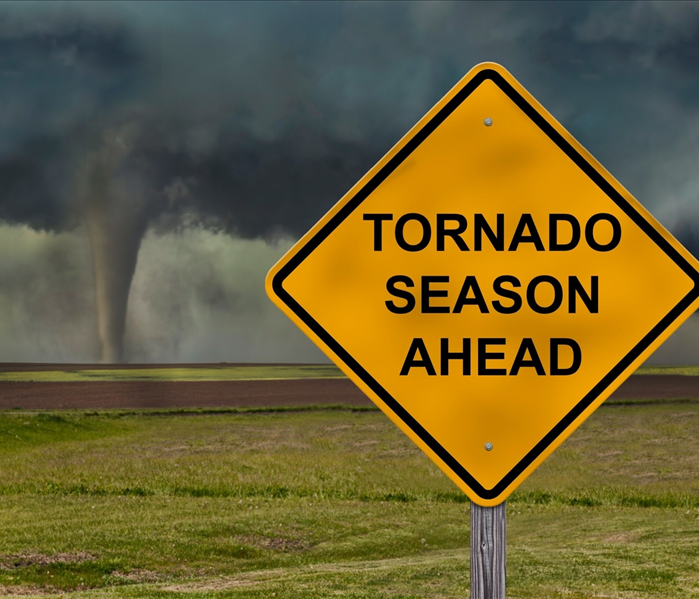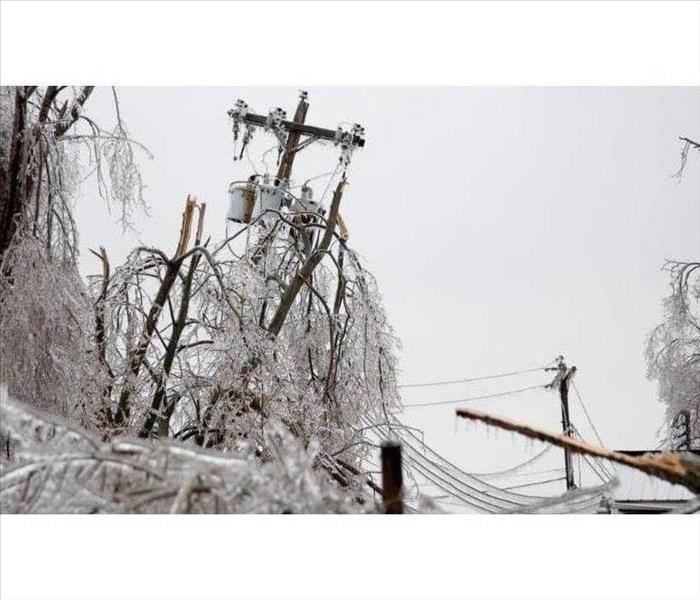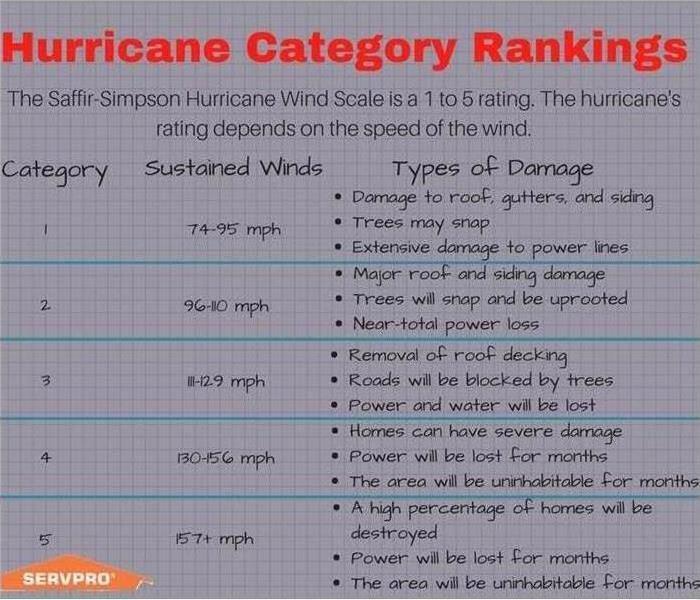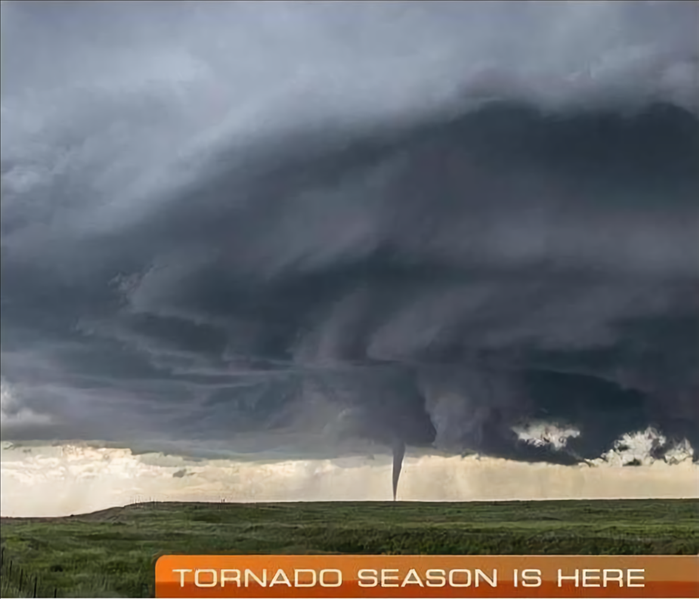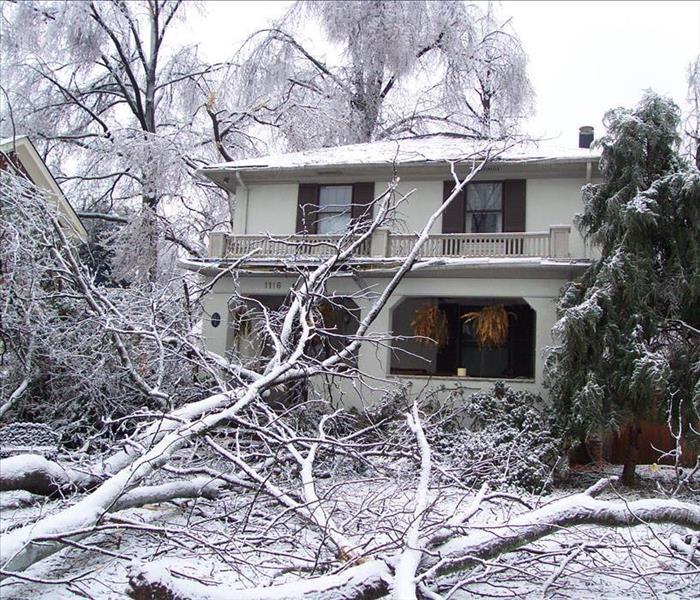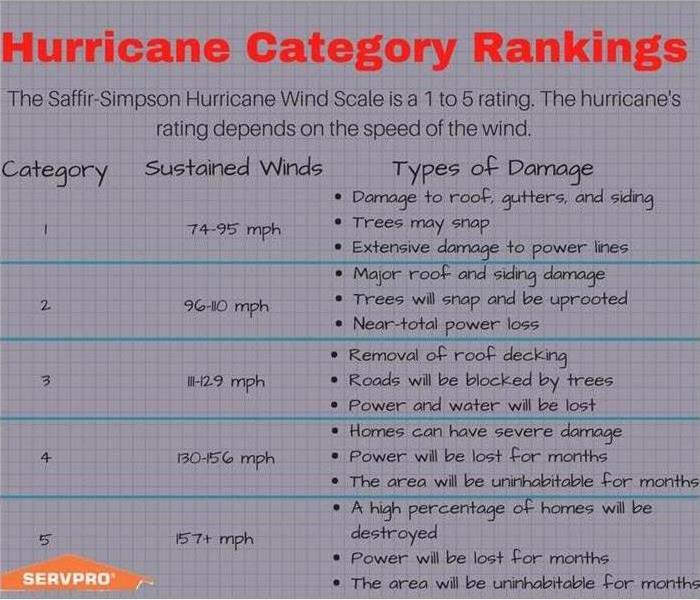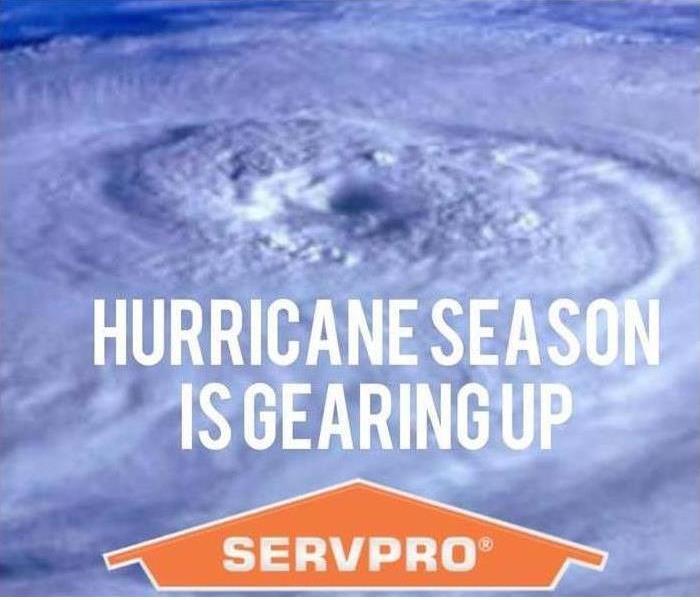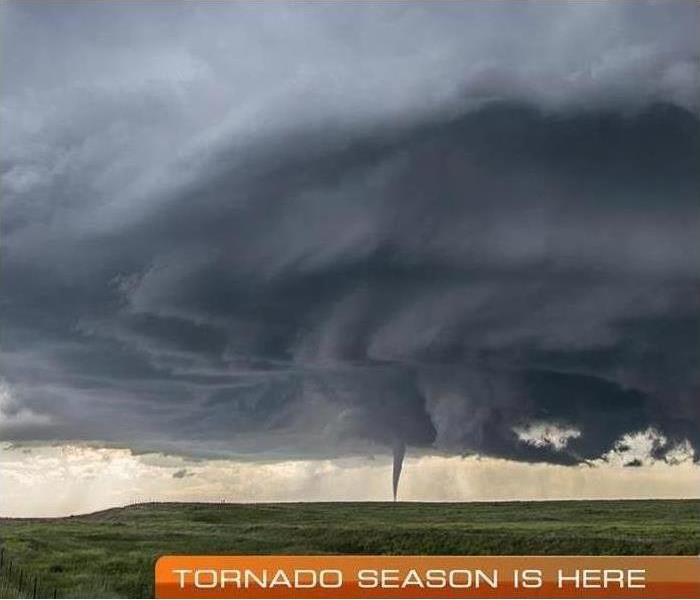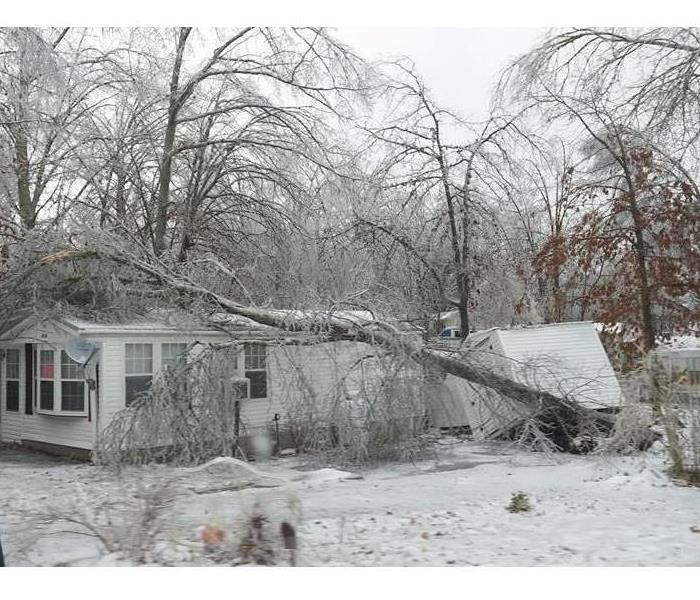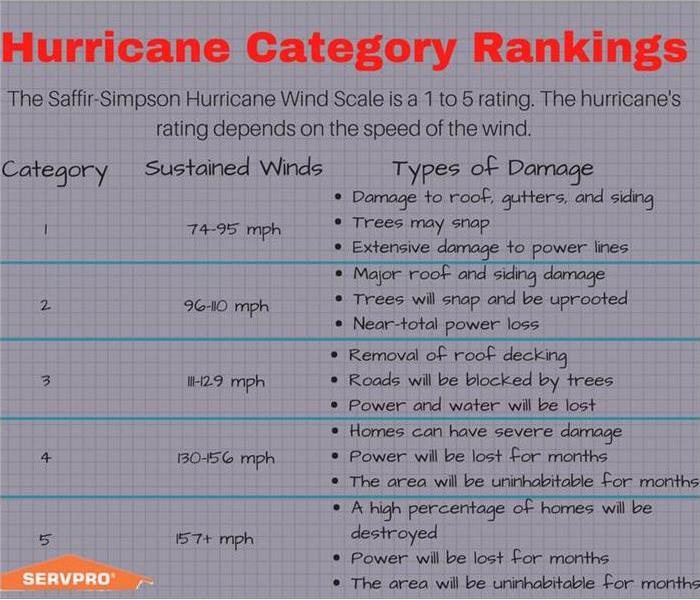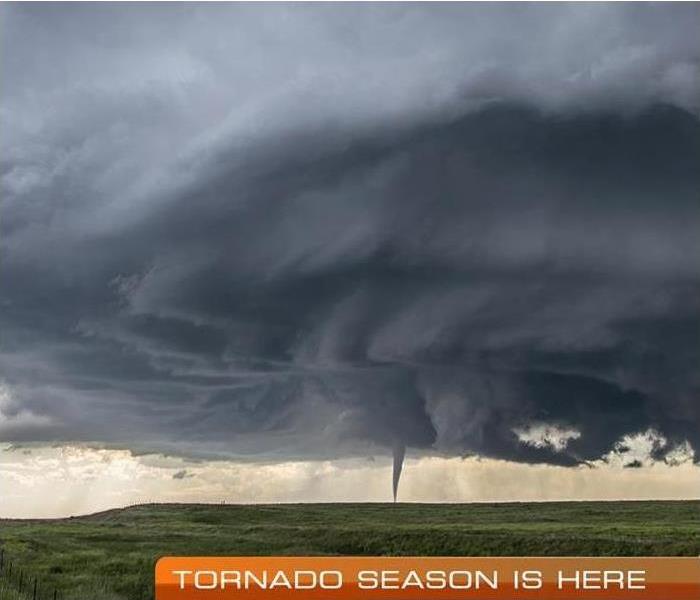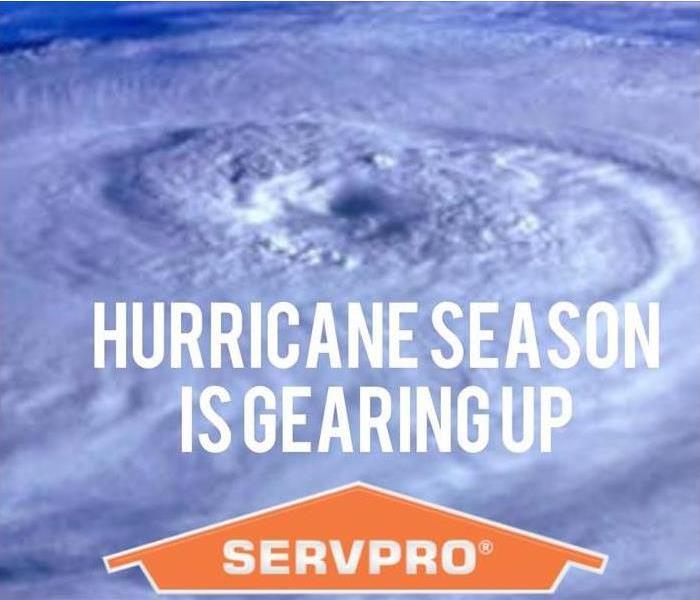Archived Storm Damage Blog Posts
The Impact of Storms: Understanding and Mitigating Damage
7/1/2024 (Permalink)
Introduction
Storms, whether they be hurricanes, tornadoes, or severe thunderstorms, have a profound impact on communities around the world. The damage they inflict can be catastrophic, affecting lives, properties, and the environment. Understanding the various types of storm damage and how to mitigate them is crucial for preparedness and recovery.
Types of Storm Damage
- Wind Damage
High winds can tear roofs off buildings, uproot trees, and turn loose debris into dangerous projectiles. The power of wind during a storm is often underestimated, but it is one of the primary causes of structural damage.
- Water Damage
Flooding from heavy rains or storm surges can cause extensive water damage to homes and infrastructure. Water can weaken foundations, destroy electrical systems, and lead to mold growth, which poses health risks long after the storm has passed.
- Lightning Damage
Lightning strikes during storms can cause fires, power outages, and severe damage to electrical systems. The intense heat of a lightning strike can ignite buildings and forests, leading to widespread destruction.
- Hail Damage
Hailstones, some as large as golf balls, can cause significant damage to roofs, windows, and vehicles.
Mitigation Strategies
- Building Codes and Standards
Implementing and adhering to strict building codes can significantly reduce the damage caused by storms. Structures built to withstand high winds and flooding are less likely to suffer severe damage.
- Early Warning Systems
Investing in advanced weather prediction technologies and early warning systems can save lives and reduce damage. Early warnings give people time to evacuate or take necessary precautions.
- Flood Defenses
Constructing levees, floodwalls, and other flood defenses can protect vulnerable areas from rising waters. Proper drainage systems and the preservation of natural wetlands can also mitigate flood damage.
- Community Preparedness
Educating communities about storm preparedness and response can empower individuals to protect themselves and their properties. Emergency plans, evacuation routes, and disaster kits are essential components of community readiness.
Recovery and Resilience
The aftermath of a storm is often a time of chaos and rebuilding. Effective recovery efforts require coordinated actions from governments, non-profits, and local communities. Financial assistance, mental health support, and rebuilding infrastructure are critical for helping affected areas recover and become more resilient to future storms.
Conclusion
Storm damage is an inevitable part of living in many regions of the world. However, with proper preparation, mitigation, and recovery strategies, the impact of these natural disasters can be significantly reduced. By building stronger, being informed, and working together.
Understanding the devastating effects of storms and the importance of mitigation and preparedness is essential for minimizing damage and enhancing recovery efforts. By sharing knowledge and resources, we can better protect our homes, our communities, and our environment from the destructive power of nature.
Do you know the differences between hurricane categories?
6/11/2023 (Permalink)
Starting in the middle of the year, from June to November, Hurricane season batters the country's coasts. This increase in tropical storms and hurricanes can lead to high levels of property damage and even devastate entire communities. Knowing the differences between hurricane categories can allow for preparations to reduce potential damage and may save your life!
Category 1 Hurricane - 74-95 mph winds - Expect damage to the roofing, gutters, and siding. Trees have an increased chance of snapping or toppling and possible damage to local power lines.
Category 2 Hurricane - 96-110 mph winds - Severe damage to roofing and siding likely. Trees and signage are expected to snap or uproot. Potential for near-total power loss locally.
Category 3 Hurricane - 111-129 mph winds - High wind speeds are likely to rip out roofing, siding, and decking. High chance of blocked roads from debris and flooding. High likelihood that local power is lost.
Category 4 Hurricane - 130-156 mph winds - Severe property damage expected. Power may be lost for weeks or months. The affected area will likely be uninhabitable for some time.
Category 5 Hurricane - 157+ mph winds - A large number of homes expected to be destroyed. Power may be lost for months. The affected area will be uninhabitable for some time.
Hurricane categories frequently change as the storm nears landfall, so it is crucial to stay up-to-date with the newest information possible. Weather stations and apps can help relay this info and any orders given by local authorities!
Be Prepared this Tornado Season!
6/3/2023 (Permalink)
Prepared for tornado season? You should be!
Every year, tornadoes spike significantly in touchdowns and sightings from late spring to early summer. An increase in the number of tornadoes, unfortunately, brings an increase in the damage and destruction they leave in their wake. Thousands of families are affected by these monstrous natural disasters every year, which is why it is crucial to be prepared!
Tornadoes form in the blink of an eye, often with little warning. This is even more true when these disasters form during the night. Fortunately, weather broadcasts can keep you updated on the severity of the storm and alert you with tornado warnings or watches.
One of the best ways to be prepared for a natural disaster like a tornado is to create emergency kits or "go bags"! These kits should contain warm blankets, clothing, medical supplies, non-perishable food, water, and potential necessities like flashlights. In a disaster, these items can support you until help arrives!
Are You Prepared for the 2023 Hurricane Season?
6/3/2023 (Permalink)
The 2023 Hurricane season is already here! Every year, from the beginning of June to the end of November, severe tropical storms and hurricanes see a significant spike in activity. Being knowledgeable and having a plan ready can help massively when in the path of a natural disaster!
First, create an emergency kit to keep stored away. Backpacks or duffel bags work great for these kits, as they can be quickly picked up and brought along in an emergency! The contents of your kit should include things like warm blankets or additional clothing, medical supplies, food, water, and other helpful things like flashlights and portable battery banks to keep things charged.
Secondly, take the time to research and learn what each category of hurricane means and the dangers they present. Knowing is half the battle when it comes to being prepared! Your home may be suited to sustain a low-category storm, but you could end up trapped should the category increase after the time to evacuate has passed.
Lastly, remember to always keep up-to-date with storm developments via weather broadcasts. You don't want to be caught off-guard or unprepared!
Are You Taking the Right Precautions During Severe Storms?
7/1/2022 (Permalink)
Severe weather can appear out of nowhere and usually sees a significant increase during the hotter months of the year. Knowing what to do when caught out by a severe storm can save your life. Severe weather may seem relatively safe, but danger can be lurking within.
Firstly, seek out shelter if you are caught outside during a storm. Rain and hail are always secondary concerns when you are caught outside during a severe storm. High wind speeds can pick up and throw around debris at incredibly dangerous speeds.
Second, if you are far from any known shelter the next best thing you can do is to locate a low point in the ground and take cover within. Using this helps to avoid any potential flying debris from severe weather or even tornadoes. Most injuries from severe weather are caused by blunt trauma from flying debris, so staying low or in shelter vastly decreases the chances of those types of injury!
Third, if a conventional shelter is out of the question then a vehicle is your next best option. Find somewhere to hunker down and take cover inside, preferably getting low to the floor.
Finally, stay up to date with severe weather within your region. Apps, radio stations, and television can all keep you updated on the severity of storms as they roll through.
Stay safe and remember, SERVPRO is always here to help!
2022 Natural Disaster Emergency Kit
6/23/2022 (Permalink)
An emergency kit may seem like a simple or even trivial concept, but it could save your life, especially when dealing with the effects of a natural disaster. Approximately 48% of homes in the United States are not equipped with an emergency kit for situations that may demand them. If you find yourself among that percentage, it's time to get to work!
When creating an emergency kit, always focus on the essential items for its purpose. Food, clean water, extra clothing, and first aid are among the most important things you should pack. Other things like blankets, flashlights, and survival utensils offer the benefits you may need if stuck outdoors. With an idea of what to pack, let's now look at where they'll go. Duffel bags or outdoor backpacks are perfect emergency kit containers. They offer ample space for storage and can be quickly thrown on at a moment's notice!
SERVPRO is always here to help in any way we can, no matter the circumstances!
Do You Know How Dangerous Hurricanes Can Be?
6/9/2022 (Permalink)
When people think of property damage, they often overlook the impact that storms and inclement weather can have. However, storm damage is much more common than many may think. The middle of the year sees a significant increase in tropical storms, and many eventually develop into full-fledged hurricanes. While the damage output of these storms starts low when dealing with low categories, it rises exponentially as they worsen!
Category 1 - 74-95 mph winds - Damage to the roof, gutters, and siding is common. Trees may snap, and there may be extensive damage to power lines.
Category 2 - 96-110 mph winds - Major roof and siding damage is possible, trees will begin to snap and uproot, and potential for near-total power loss.
Category 3 - 111-129 mph winds - High winds cause the removal of roof tiling and decking, a high chance of debris blocking roads, and the likelihood that power and water are lost is high.
Category 4 - 130-156 mph winds - Severe damage to homes likely, power may be lost for months, and the area will be uninhabitable for an extended period.
Category 5 - 157+ mph winds - A high percentage of homes will be destroyed, power will be lost for months, and the area will be uninhabitable for months.
Use this information for when a potential storm is coming your way. Stay updated via weather stations and apps, and follow orders given by local and state governments!
2022 Hurricane Season
5/18/2022 (Permalink)
Hurricane season beings in just a few short weeks! The second half of the calendar year sees a large spike in the number of tropical storms, and during this time they are much more likely to further develop into a hurricane. Are you prepared for severe tropical weather? It's time to do some research and create a plan to follow when you're in the path of a hurricane!
One of the best preparatory steps you can take is to create emergency "go-bags". A go-bag is a duffle bag or backpack that you can quickly grab during an emergency. They often contain the essentials that you'd need to survive if you end up stranded for a short time. Nonperishable food, water, fresh clothes, and medicine are all fantastic to keep ready to go!
It's also incredibly useful to learn the differences between all of the hurricane categories! Knowing is half the battle when it comes to being prepared. You may not be ready for a stronger storm, and when you don't know the difference you make be putting yourself in danger! It's important to know when it's better to hunker down and board up the windows and when it's time to evacuate.
Remember to always stay updated on new developments with any tropical storm so that you're never caught off guard or left unprepared!
2022 Tornado Season
5/16/2022 (Permalink)
Tornado season has started! Every year there is a significant increase in sightings and touchdowns of tornadoes from late spring to early summer. With the increase in sightings and touchdowns, there is also an increase in damage and devastation. Thousands are affected by these natural disasters yearly, which is why proper preparation and safety measures are so important. It always pays to be prepared.
A tornado can form in the blink of an eye and with very little warning. This is especially true for ones that form under the cover of night. Keep a weather broadcast running during severe weather for updates on the severity of the storm and to stay up-to-date with warnings and watches.
Finally, have an emergency kit at the ready in the event of a disaster. Warm blankets or clothes, first aid, food, and water can all go a long way in keeping you safe if disaster strikes!
Are You Prepared for Severe Winter Weather?
2/10/2022 (Permalink)
Winter storms cause much more damage than you likely realize. With heavy snowfalls, sporadic flooding, slick/icy roads and walkways, and extreme wind speeds there is a multitude of ways your home can face damage. Being caught out during severe weather could even put your life in danger. Creating a plan to follow in the event of an emergency is always a great first step!
Excessive amounts of snowfall can cause more damage to property than many know. It continues to pile on weight until structures just can't support it any longer and cave under the pressure.
When facing high wind speeds there is the potential of objects and debris being caught in the wind and thrown around at dangerous speeds. Damages to the exterior and windows of buildings are common but vehicles left out in the storm can also fair poorly. These broken windows and damaged exterior can let snow and water where they shouldn't be, leading to potential water or mold damage!
Icy walkways and driveways create a dangerous obstacle to face when leaving for work or while making a path through the snow. Be cautious to avoid taking a hard fail.
The examples above are just a fraction of the ways that winter storms impact people all across the country annually. Pay attention to local weather channels and be aware of any alerts issued to help properly prepare for the approaching storm. Create a plan with the whole family and practice it often, and be sure to put together bags packed with essentials like food, water, and warm clothing for sudden emergencies. Most of all, stay safe and stay warm!
Take the proper precautions during severe storms!
7/4/2021 (Permalink)
Severe weather can appear out of nowhere, especially during the hot summer months, because of that it is important that you and your family understand the proper steps that you should take when a severe storm rolls through that has the potential to turn dangerous.
First, if you are not at your home then you should seek out sturdy shelter. Any rain and hail should be secondary concerns when caught out in severe weather. Wind speeds picking up can send debris flying through the air at dangerous speeds.
Secondly, if you are unable to find shelter and are caught out try to find a low point along the ground. Taking cover this way will help avoid potential flying debris, winds, lightning, and even tornadoes. One of the best things you can do if you are caught out with a tornado bearing down on you is to find a deep ditch and curl up in it, focusing protection on your head and face.
Third, if you can't find conventional shelter a vehicle will do, the most important thing is to find somewhere to hunker down and take cover.
Lastly, be sure to stay updated on the severity of the storm via your radio, phone, or television.
Stay safe and remember, SERVPRO is always here to help!
2021 Natural Disaster Emergency Kit Creation
6/25/2021 (Permalink)
Did you know that as many as 48.5% of homes in the United States don't have an emergency kit put together and ready to go in the event of a natural disaster or home emergency? While being a simple concept, having an emergency kit at the ready can quite literally save your life, especially during natural disasters like hurricanes or tornadoes!
Packing things like travel food, clean water along with a few extra clothes, important medicine or medical supplies, and more things that you think would help in the event of such a disaster like blankets, or any equipment you can use (flashlights, lanterns, canteens, etc). All of these things can be stored in something as simple as a duffel bag or even a backpack so that if or when the time comes you can grab it and go!
Remember, SERVPRO is always here to help in any and every way that we can!
2021 Hurricane Category Information
6/10/2021 (Permalink)
Here at SERVPRO, we deal with all types of damages to property, one of the most common types that we deal with is water/storm damage. The season that causes the most water and storm damage during the year is already here, hurricane season has begun and with that, it is important that you know the differences in the category. The difference in potential damage is exponential and can sometimes leave your home in ruin.
Category 1 - 74-95 mph winds - Can cause damage to the roof, gutters, and siding. Trees may snap and there could be extensive damage to power lines.
Category 2 - 96-110 mph winds - Can cause major roof and siding damage, trees will snap and uproot, near-total power loss.
Category 3 - 111-129 mph winds - Can cause the removal of roof decking, roads will be blocked by trees, power and water will be lost.
Category 4 - 130-156 mph winds - Can cause severe damage to homes, power will be lost for months, the area will be uninhabitable for months.
Category 5 - 157+ mph winds - A high percentage of homes will be destroyed, power will be lost for months, the area will be uninhabitable for months.
Use this information for when a potential storm is coming your way, and be sure to evacuate if directed to, your life is more important than your home. SERVPRO will always be there to help in the clean-up.
2021 Hurricane Season
5/19/2021 (Permalink)
As we start to get into the Summer months the 2021 Hurricane season is going to start to pick up, and knowing what to do and where to go should a hurricane hit is extremely important. Its important that you and your family are properly following the steps and taking all precautions available when a hurricane is bearing down on you. Your wellbeing is more important than potential property damage.
Taking precautionary steps like setting up emergency kits and bug-out-bags is smart and will give you more time that you may need during a storm. It is also a good idea to learn and teach the differences of each category of hurricane so that everyone in your household knows the severity of what is to come. Knowing when to hunker down and wait out the storm and when to evacuate is another important task. Stay too long and your home may succumb to severe flooding and you may end up trapped. We urge you to stay safe through this years hurricane season, and if disaster strikes you know who to call.
2021 Tornado Season
5/18/2021 (Permalink)
Summer is just around the corner and that means tornado season going to start picking up. Every year there is an increase in tornado sightings and touchdowns during the late Spring and Summer months, and that means hundreds of homes and communities will be left in the wake of a natural disaster. Learning and understanding the safety steps and measures that should be taken when a tornado touches down near you is incredibly important. It always pays to be prepared.
Tornadoes can and will strike out of nowhere and with little to no warning, especially when one touches down during the evening or at night. It's important for you and your family to know the signs of a tornado forming, what certain public safety announcements mean (the difference between warning and watch), and how to make an emergency kit that will keep you safe and provide for you in case the worst happens. Stay safe this season, and if your home experiences disaster you know who to call.
Are you prepared for Winter storms?
2/11/2021 (Permalink)
Do you know how much damage Winter storms can actually cause? Heavy snowfalls, flooding, icy roads and walkways, extreme wind speeds and much more that can cause severe damage to your home or property. Being caught out without shelter or power and no preparation could potentially mean life or death. Having a plan in the event of an emergency is always a great idea along with multiple "go bags" ready to go ASAP!
Excessive snowfall can cause damage to your home by adding excess weight to the roof and potentially causing it to cave in on itself.
High wind speeds have the possibility of throwing dangerous objects at your home or through your windows, while also damaging any vehicles left out in the storm. The last thing you want during a powerful winter storm or blizzard is to have a broken window in which snow and water can accumulate and cause damage!
Ice can build up on your walk-ways and driveway and become a dangerous obstacle for you to face when leaving for work or while shoveling. You don't want to take a hard fall and injure yourself.
These examples are just a fraction of the ways that Winter storms impact people across the country yearly. Pay attention to your weather channels and make note of any alerts that are issued by your state/district, these could help you prevent damage to your home. Put together a plan with your family and practice it frequently if you have little ones, make sure to keep long shelf life supplies ready to go and stored away as well! Stay safe and stay warm this winter!
Do you know the proper steps to take during a severe storm?
7/8/2020 (Permalink)
Storms have the ability to appear out of the blue, especially during the summer months, that said it is important that you and your families understand the proper steps to take when a severe storm rolls in that could potentially become dangerous.
Firstly, if you are not home seek out sturdy shelter. Rain and hail are secondary concerns when dealing with large storms because once the winds pick up they flying debris becomes much more common / dangerous.
Secondly, if you are unable to find shelter and are caught out try to find a low point along the ground. Taking cover this way will help avoid potential flying debris, winds, lightning, and even tornadoes. One of the best things you can do if you are caught out with a tornado baring down on your is to find a deep ditch and curl up in it, focusing protection to your head and face.
Third, if you can't find conventional shelter a vehicle will do, the most important thing is to find somewhere to hunker down and take cover.
Lastly, be sure to stay updated on the severity of the storm via your radio, phone, or television.
Stay safe and remember, SERVPRO is always here to help!
Natural Disaster Emergency Kit Awareness
6/26/2020 (Permalink)
Did you know that as many as 48.5% of United States homes don't have an emergency kit ready to go in the event of a natural disaster or home emergency? As simple as the concept of it is, an emergency kit could quite literally save your life in the event of a natural disaster like a hurricane or tornado!
Packing things like travel food, clean water along with a few extra clothes, important medicine or medical supplies, and more things that would help in the event of such a disaster like blankets, equipment you can use (Flashlights, lanterns, canteens, etc). All of these things can be stored in something as simple as a duffel bag so that if or when the time comes you can grab it and go!
Remember, SERVPRO is here to help in any and every way that we can!
2020 Hurricane Categories Info
6/11/2020 (Permalink)
Here at SERVPRO we deal with all types damages to property, one of the most common types that we deal with is water/storm damage. On the topic of water and storm damage the hurricane season is beginning soon and with that it is important to know and understand the differences between categories and what type of damage they can produce.
Category 1 - 74-95 mph winds - Can cause damage to roof, gutters and siding. Trees may snap and there could be extensive damage to power lines.
Category 2 - 96-110 mph winds - Can cause major roof and siding damage, trees will snap and uproot, near-total power loss.
Category 3 - 111-129 mph winds - Can cause removal of roof decking, roads will be blocked by trees, power and water will be lost.
Category 4 - 130-156 mph winds - Can cause severe damage to homes, power will be lost for months, the area will be uninhabitable for months.
Category 5 - 157+ mph winds - A high percentage of homes will be destroyed, power will be lost for months, the area will be uninhabitable for months.
Use this information for when a potential storm is coming your way, and be sure to evacuate if directed to, your life if more important than your home. SERVPRO will always be there to help in the clean up.
Hurricane Season 2020
5/21/2020 (Permalink)
Summer is almost here, and with it comes a few of its undesirable friends. The 2020 hurricane season is just around the corner, and with it comes the importance of knowing what to do if a hurricane were to come your way. Making sure that you and your family are following the proper steps and precautions when dealing with a hurricane is important. You and your family's lives are more important than potential property damage.
Taking precautionary steps like setting up emergency kits and bug-out-bags is smart and will give you more time that you may need during a storm. It is also a good idea to learn and teach the differences of each category of hurricane so that everyone in your household knows the severity of what is to come. Knowing when to hunker down and wait out the storm and when to evacuate is another important task. Stay too long and your home may succumb to severe flooding and you may end up trapped. We urge you to stay safe through this years hurricane season, and if disaster strikes you know who to call.
Tornado Season 2020
5/21/2020 (Permalink)
Summer is only just a few weeks away and with it comes some of its nasty friends. Tornado season officially began just a few months back and within that time hundreds of homes and communities have be struck by the hardship that comes when a natural disaster strikes. It is important to lay out steps and safety measures in the event that one of these disasters strikes where you live. It always pays to be prepared.
Tornadoes can and will strike out of nowhere and with little to no warning, especially when one touches down during the evening or at night. It's important for you and your family to know the signs of a tornado forming, what certain public safety announcements mean (the difference between warning and watch), and how to make an emergency kit that will keep you safe and provide for you in case the worst happens. Stay safe this season, and if your home experiences disaster you know who to call.
Be Ready for Winter Storms!
2/14/2020 (Permalink)
Do you know the true power that Winter storms possess? Heavy snowfall, flooding, ice, extreme wind speeds, and much more can cause severe damage to your home during a time where being caught without shelter or power could potentially mean life or death. It is always wise to have a plan set in place and one or more "go" bags ready to be used in a moment's notice!
Excessive snow can quickly pile up and cause damage to your home by collapsing the roof. This can further lead to things like water and mold damage now that it has entered your home.
Extreme winds can lead to shattered windows and damaged roofing/vehicles. The last thing you want during a powerful winter storm or blizzard is to have a broken window in which snow and water can accumulate and cause damage!
Ice can build up on your walk-ways and driveway and become a dangerous obstacle for you to face when leaving for work or shoveling. The last thing you need is to take a hard fall and injure yourself.
These are just a few of the ways that winter storms can leave both you and your property damaged and in need of repair. Pay attention to your weather channels and any alerts that are issued by your state/district, these could help you prevent damage to your home. Put together a plan with your family and practice it a lot if you have little ones, make sure to keep long shelf life supplies ready to go and stored away as well! Stay safe and stay warm this winter!
Do you know what to do during a severe storm?
7/11/2019 (Permalink)
Storms can happen out of nowhere, especially during the Summer, so it is important that you and your loved ones understand what to do if a severe storm rolls in that looks like it could be potentially dangerous.
First, if you are outdoors seek out shelter. While the rain may get you wet that shouldn't be your main concern when dealing with a large storm. Wind speeds normally rise during large storms and flying debris can be dangerous.
Second, if you can't get to shelter, even a car will do, the best thing you can do is find cover in a low point. Depending on the storm this will protect you from winds, lightning (due to you going to a lower altitude), and even tornadoes. One of the best things you can do if you are caught out with a tornado baring down on you is to find a ditch and curl up in it, protecting your face and head.
Lastly, be sure to listening to news stations on the radio or television to understand the severity of the storm. Be on the look out for tornado watches and warnings.
Stay safe and remember, SERVPRO is here to help!
Natural Disaster Emergency Kit Awareness
6/22/2019 (Permalink)
Did you know that as many as 48.5% of United States homes don't have an emergency kit ready to go in the event of a natural disaster or home emergency? As simple as the concept of it is, an emergency kit could quite literally save your life in the event of a natural disaster like a hurricane or tornado!
Packing things like travel food, clean water along with a few extra clothes, important medicine or medical supplies, and more things that would help in the event of such a disaster like blankets, equipment you can use (Flashlights, lanterns, canteens, etc). All of these things can be stored in something as simple as a duffel bag so that if or when the time comes you can grab it and go!
Remember, SERVPRO is here to help in any and every way that we can!
2019 Hurricane Categories Info
6/14/2019 (Permalink)
Here at SERVPRO we deal with all types damages to property, one of the most common types that we deal with is water/storm damage. On the topic of water and storm damage the hurricane season is beginning soon and with that it is important to know and understand the differences between categories and what type of damage they can produce.
Category 1 - 74-95 mph winds - Can cause damage to roof, gutters and siding. Trees may snap and there could be extensive damage to power lines.
Category 2 - 96-110 mph winds - Can cause major roof and siding damage, trees will snap and uproot, near-total power loss.
Category 3 - 111-129 mph winds - Can cause removal of roof decking, roads will be blocked by trees, power and water will be lost.
Category 4 - 130-156 mph winds - Can cause severe damage to homes, power will be lost for months, the area will be uninhabitable for months.
Category 5 - 157+ mph winds - A high percentage of homes will be destroyed, power will be lost for months, the area will be uninhabitable for months.
Use this information for when a potential storm is coming your way, and be sure to evacuate if directed to, your life if more important than your home. SERVPRO will always be there to help in the clean up.
Tornado Season 2019
6/3/2019 (Permalink)
Summer is here, but it brings a long a few of its nasty friends with it. Tornado season officially began just a few months back and within that time hundreds of homes and communities have be struck by the hardship that comes when a natural disaster strikes.
Tornadoes can and will strike out of nowhere and with little to no warning, especially when one touches down during the evening or at night. It's important for you and your family to know the signs of a tornado forming, what certain public safety announcements mean (the difference between warning and watch), and how to make an emergency kit that will keep you safe and provide for you in case the worst happens. Stay safe this season, and if your home experiences disaster you know who to call.
Hurricane Season 2019
6/3/2019 (Permalink)
Summer has arrived, and its brought a few of its undesirable friends. The 2019 hurricane season has start just this past weekend, and with it comes the importance of knowing what to do if one comes your way. Taking the correct steps towards safety for you and your family should take priority during a hurricane, even if it means your property may be damage in doing so.
Taking precautionary steps like setting up emergency kits and bug-out-bags is smart and will give you more time that you may need during a storm. It is also a good idea to learn and teach the differences of each category of hurricane so that everyone in your household knows the severity of what is to come. Knowing when to hunker down and wait out the storm and when to evacuate is another important task. Stay too long and your home may succumb to severe flooding and you may end up trapped. We urge you to stay safe through this years hurricane season, and if disaster strikes you know who to call.
When Storms or Floods hit Hanover Township/BearCreek, SERVPRO is ready!
10/10/2017 (Permalink)
SERVPRO of Hanover Township/Bear Creek specializes in storm and flood damage restoration. Our crews are highly trained and we use specialized equipment to restore your property to its pre-storm condition.
Faster Response
Since we are locally owned and operated, we are able to respond quicker with the right resources, which is extremely important. A fast response lessens the damage, limits further damage, and reduces the restoration cost.
Resources to Handle Floods and Storms
When storms hit SERVPRO of Hanover Township / Bear Creek, we can scale our resources to handle a large storm or flooding disaster. We can access equipment and personnel from a network of 1,650 Franchises across the country and elite Disaster Recovery Teams that are strategically located throughout the United States.
Have Storm or Flood Damage? Call Us Today (570) 822-4700
Nanticoke Floods
7/12/2017 (Permalink)
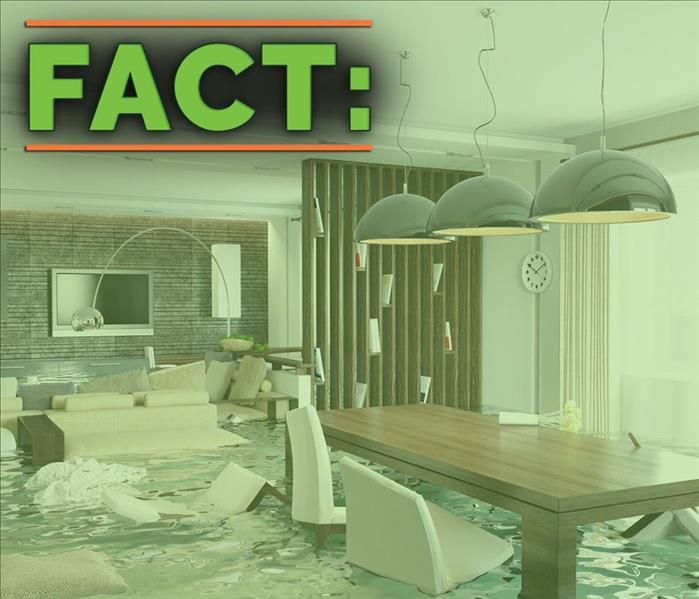 Floods Happen!
Floods Happen!
In 2011, the Nanticoke, Pennsylvania area experienced an epic flood when the banks of the Susquehanna river over flowed because of rain from Tropical Storm Lee. Homes and business throughout the area were damaged or destroyed and many lives were forever changed. Did you know that flooding is the #1 cause for insurance claims? Surprisingly, most homeowners or business owners don't have flood coverage and unfortunately don't find this out until it is too late. Take the time to review your insurance policy and meet with your insurance agent to add additional coverage if needed. In the event that your home or business is affected by flooding waters, know that SERVPRO of Hanover Township / Bear Creek is here to assist you in your time of need.
When Storms or Floods hit Hanover Township/ Bear Creek, SERVPRO is ready!
5/16/2016 (Permalink)
SERVPRO of Hanover Township/ Bear Creek specializes in storm and flood damage restoration. Our crews are highly trained and we use specialized equipment to restore your property to its pre-storm condition.
Faster Response
Since we are locally owned and operated, we are able to respond quicker with the right resources, which is extremely important. A fast response lessens the damage, limits further damage, and reduces the restoration cost.
Resources to Handle Floods and Storms
When storms hit Hanover Township/ Bear Creek , we can scale our resources to handle a large storm or flooding disaster. We can access equipment and personnel from a network of 1,650 Franchises across the country and elite Disaster Recovery Teams Storm Restoration that are strategically located throughout the United States.
Have Storm or Flood Damage? Call Us Today- 570-722-5700






 24/7 Emergency Service
24/7 Emergency Service
